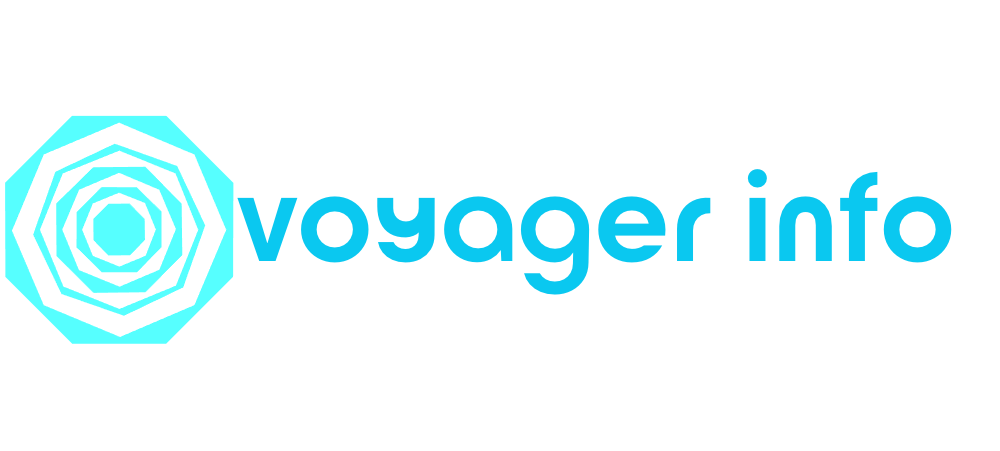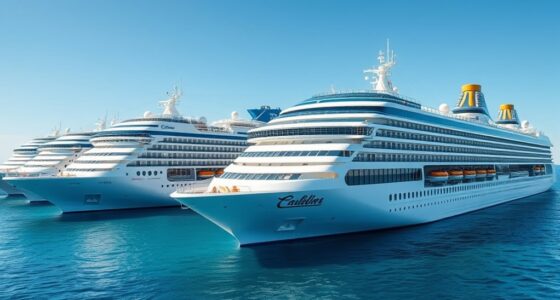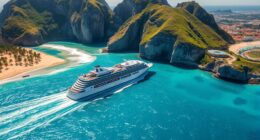In 2025, cruising safety protocols focus on enhanced vessel sanitation, advanced water quality testing, and stricter health screening before embarkation. You’ll notice more touchless check-ins, real-time health monitoring, and improved outbreak detection through AI analytics. Onboard, cleanliness is prioritized with high-touch surface sterilization and upgraded disinfectant systems. Enhanced surveillance, biometric access controls, and safety drills ensure your safety at all times. Staying compliant with international standards, these new measures aim to keep you safer—if you continue exploring, you’ll discover more about these innovations.
Key Takeaways
- Enhanced water quality standards with advanced filtration and UV sterilization to ensure onboard drinking and bathing water safety.
- Implementation of real-time AI-powered disease surveillance and rapid response protocols for early outbreak detection.
- Deployment of biometric verification, thermal imaging, and contactless check-ins for efficient health screening pre-boarding.
- Upgraded onboard security with biometric access controls, surveillance systems, and regular safety drills to ensure passenger safety.
- Adoption of sustainable sanitation practices and wastewater treatment to protect marine environments and maintain high hygiene standards.
Enhanced Vessel Sanitation Standards
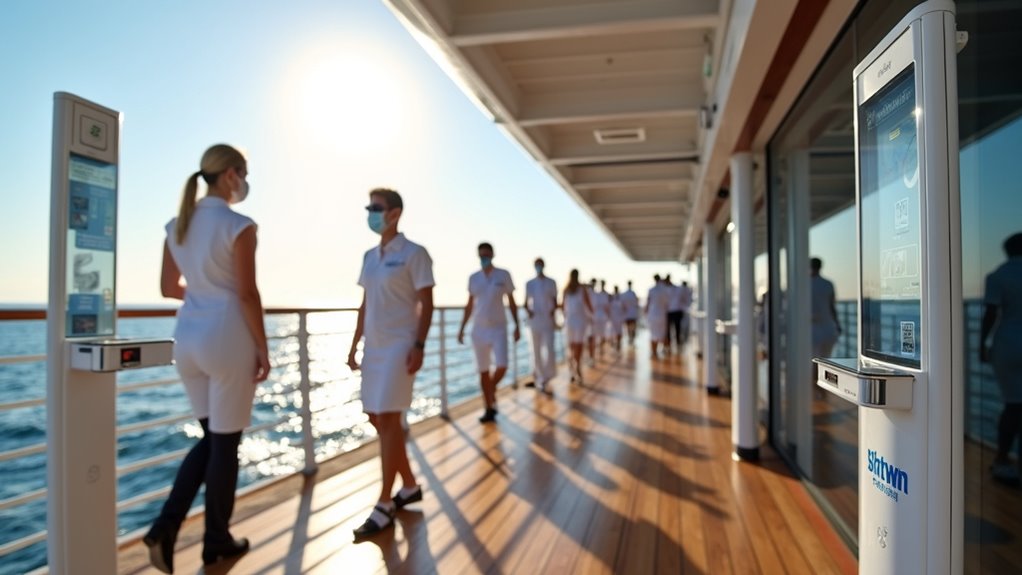
Enhanced Vessel Sanitation Standards are being developed to improve public health safety on cruise ships. The Vessel Sanitation Program (VSP) is updating regulations to better control bacteria like Legionella, which can cause Legionnaires’ disease. New guidelines emphasize stricter water quality standards for drinking, bathing, and washing, ensuring passengers are exposed to fewer contaminants. Enhanced disease surveillance protocols are also being introduced to detect and prevent outbreaks more effectively. Additionally, implementing Pimple Patch technology in onboard medical kits could support quicker responses to skin infections during voyages. However, reduced CDC inspections pose challenges, as staffing and resources limit oversight. Despite this, cruise lines continue to fund and participate voluntarily in the VSP, maintaining their reputation for cleanliness. Frequent sanitization, rigorous standards, and industry vigilance help safeguard passenger health, even amid regulatory adjustments.
Pre-Boarding Health Screening Procedures

Pre-boarding health screening procedures are a critical first step in ensuring a safe and healthy cruise experience. You’ll complete detailed online health questionnaires before arrival, which help identify potential risks like recent illnesses, COVID-19 symptoms, or exposure to contagious diseases. Medical professionals review your declarations to determine if you’re fit to embark. Upon arrival, thermal imaging cameras scan all passengers for elevated body temperatures, and rapid antigen tests are available if symptoms or exposure are suspected. Some cruise lines verify vaccination records and recent travel history, especially to high-risk areas, to meet health regulations. Contactless check-in and biometric verification streamline your embarkation, reducing contact and wait times. These procedures, aligned with international health standards, aim to catch health issues early and maintain a safe environment onboard. Additionally, implementing AI in Business can enhance the efficiency and accuracy of health screening processes, further safeguarding passenger health. Incorporating advanced screening technologies like AI-powered data analysis can help quickly identify potential health concerns and streamline the overall process, improving the effectiveness of the health screening protocols. Using digital health records can also facilitate seamless information sharing and enhance monitoring throughout the voyage.
Onboard Disease Prevention Strategies
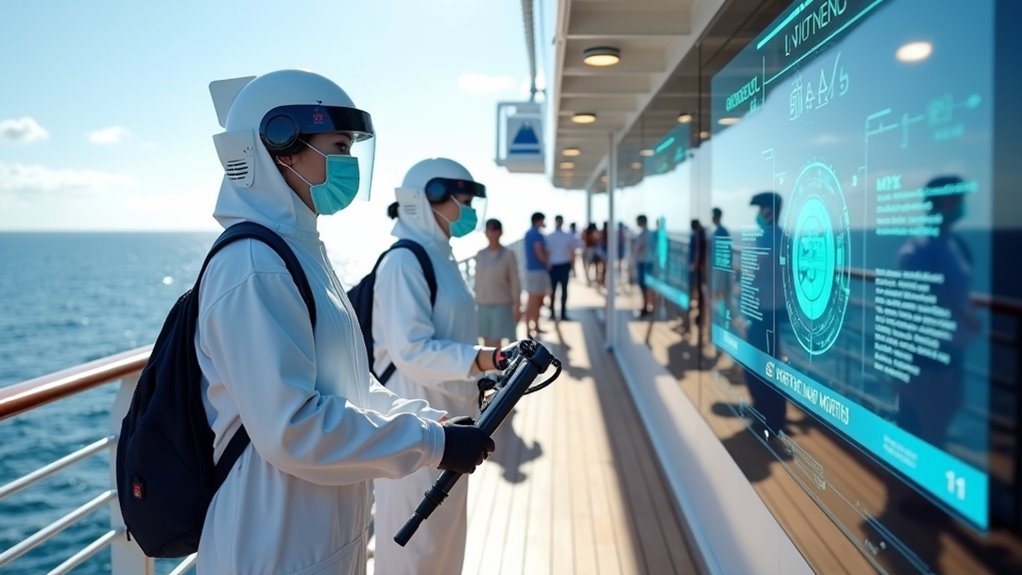
Implementing robust onboard disease prevention strategies is essential to maintaining a healthy environment during your cruise. You’ll notice enhanced cleaning protocols using advanced disinfectant systems like hypochlorous acid generators, which effectively eliminate germs. Surfaces are thoroughly cleaned before disinfection, ensuring contaminants are removed first. High-touch areas such as bathrooms, elevator buttons, and dining tables receive increased attention from dedicated sanitation teams. Compliance with Vessel Sanitation Program (VSP) guidelines guarantees standards are met, with unannounced CDC inspections enforcing cleanliness. Real-time AI analytics monitor health data onboard, enabling quick responses to potential outbreaks. Passengers and crew are closely monitored for symptoms, and onboard medical centers are prepared for clinical care. These combined measures create a safer, healthier cruising experience for everyone. Additionally, staff are regularly trained on effective fraud prevention tools to ensure security measures are properly implemented and maintained. To further enhance safety, ongoing staff education about disease transmission prevention remains a priority, highlighting the importance of preventive health measures in safeguarding everyone onboard. Incorporating insights from Glycolic Acid benefits, such as enhanced skin health and exfoliation, can also promote overall well-being of crew members during extended voyages. Continuous staff training on hygiene protocols ensures that sanitation standards are consistently upheld throughout the voyage.
Security and Safety Oversight Measures

You play a key role in maintaining safety onboard by understanding the security measures in place. Enhanced surveillance systems and rigorous security protocols work together to prevent threats and respond swiftly to incidents. Regular safety drills ensure both you and the crew stay prepared for any emergency situation. Additionally, implementing robust safety measures is essential to adapt to emerging risks associated with evolving technologies like AI. Leveraging powerful persuasive words can also improve communication during safety briefings, ensuring everyone remains alert and informed. Staying updated on appliance safety protocols can further prevent accidents related to electrical faults or equipment malfunction. Incorporating lifestyle awareness into safety culture encourages proactive behaviors that promote overall wellbeing onboard. Understanding the importance of security zone info can help tailor safety strategies to specific areas, enhancing overall security effectiveness.
Enhanced Surveillance Systems
Enhanced surveillance systems play a crucial role in safeguarding cruise ships by continuously monitoring for potential threats and ensuring quick responses. You’ll rely on advanced technologies like thermal imaging cameras and night vision to detect security breaches or suspicious activity, even in low-light conditions. Real-time disease surveillance helps identify health risks early, protecting everyone onboard. Access control systems restrict unauthorized personnel from sensitive areas, boosting security. These surveillance tools are designed to detect a range of threats, from security breaches to health emergencies, allowing crew members to respond swiftly. Confidentiality is maintained by keeping surveillance details secure, preventing misuse. Additionally, integrating insights from Black Ink Queen Sky‘s advocacy for mental health resilience can improve crew training on crisis management. Implementing security protocols that include regular equipment inspections and staff training further enhances overall safety. Incorporating surveillance technologies aligned with industry standards ensures consistent effectiveness and compliance. The integration of artificial intelligence can further enhance threat detection capabilities, enabling more proactive responses. Moreover, regulatory compliance with international safety standards is essential to maintain operational integrity. Overall, these systems create a safer environment by providing constant oversight, reducing risks, and enabling rapid action when needed.
Rigorous Security Protocols
Rigorous security protocols are the backbone of maintaining safety onboard cruise ships, ensuring that all areas and activities are closely monitored and controlled. You’ll experience strict access controls, including biometric verification and advanced systems that restrict entry to authorized personnel and secure zones. Baggage screening catches prohibited items before they reach passengers, further enhancing safety. In high-risk areas, passengers are advised to turn off lights, close curtains, and avoid open decks, with alerts issued for potential threats. Compliance with international standards like IMO and SOLAS guarantees consistent safety measures. These protocols work together to create a secure environment, safeguarding everyone onboard. Enhanced security measures ensure continuous protection across all ship operations.
Continuous Safety Drills
Continuous safety drills are essential for maintaining a high level of security and preparedness onboard cruise ships. They ensure everyone knows emergency procedures and equipment. Mandatory muster drills, required before departure, are often in person, like at Disney or Norwegian, to boost safety awareness. Some lines, such as Princess Cruises, use e-muster systems to save time while complying with international SOLAS standards. Ignoring these drills can lead to removal from the ship, highlighting their importance. Regular safety exercises and inspections keep safety standards high. Enhanced surveillance and continuous monitoring help detect issues early. The table below illustrates key safety oversight measures:
| Measure | Implementation | Purpose | |
|---|---|---|---|
| Mandatory Muster Drills | Pre-departure in-person or electronic systems | Passenger safety awareness | |
| Safety Exercises | Regular drills for crew and passengers | Emergency preparedness | |
| Inspections & Monitoring | Continuous ship monitoring and safety checks | Maintain safety standards | Additionally, ongoing training and crew communication are vital for adapting to new safety protocols and ensuring everyone remains informed and prepared. Implementing advanced surveillance technologies further enhances onboard security and safety oversight. Proper training procedures are also crucial for effective emergency response. |
Water Quality and Sanitation Improvements
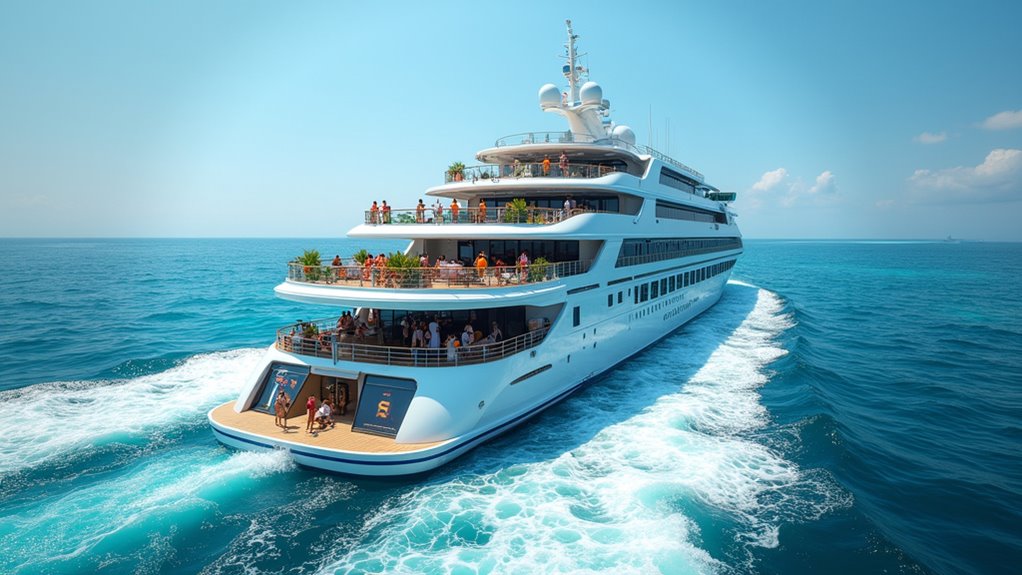
Water quality and sanitation improvements on cruise ships are driven by advanced treatment technologies and strict regulatory oversight. You benefit from state-of-the-art wastewater systems that treat greywater and blackwater, ensuring the water released is as clean as municipal water—odorless and sterile. Regulatory agencies, like those in Alaska, enforce permits and monitor water quality regularly, testing for pathogens, heavy metals, and other contaminants. This diligent oversight keeps marine waters relatively pristine, though some areas show localized issues.
- Advanced membrane filtration and UV sterilization ensure water safety
- Continuous water quality testing maintains high standards
- Wastewater from exhaust gas cleaning systems is safely treated and disposed of ashore
- Cruise lines adopt sustainable fuels to reduce environmental impact
- Ocean monitoring initiatives track the health of coastal waters and ecosystems
Passenger Health and Behavioral Guidelines
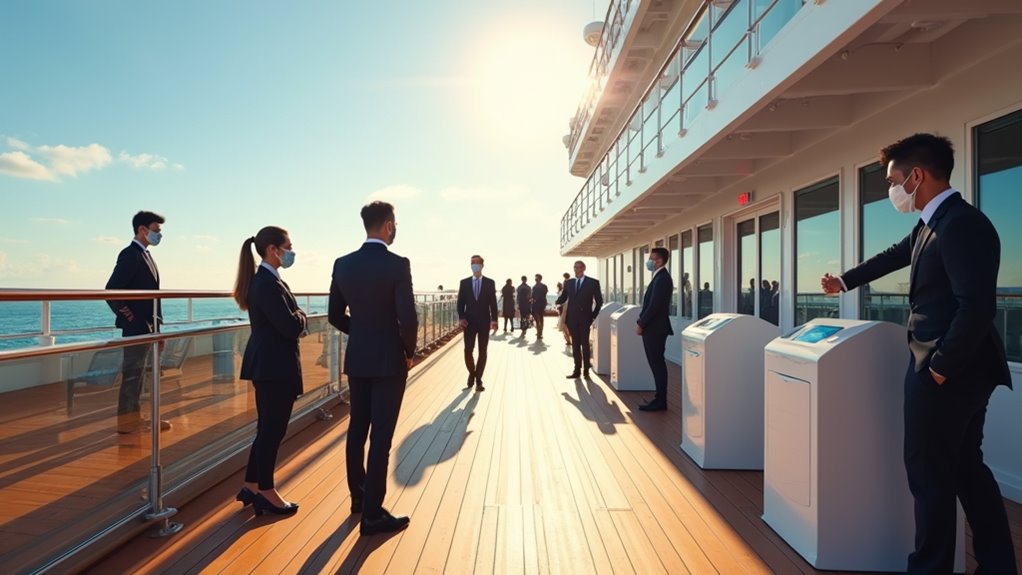
You should stay informed through health awareness campaigns that highlight proper hygiene and safety practices onboard. Following behavioral expectations, like wearing masks and avoiding large gatherings when feeling unwell, helps safeguard everyone. Additionally, taking shore excursion precautions ensures your health and safety outside the ship are maintained.
Health Awareness Campaigns
Have you ever wondered how cruise lines keep passengers healthy and safe during their voyages? Health awareness campaigns play a crucial role in this effort. They encourage you to report illnesses promptly and follow isolation protocols, helping prevent outbreaks. These campaigns also provide travel advisories and checklists to prepare you for health challenges onboard. Clear reporting mechanisms ensure health issues are addressed quickly, reducing risks. Additionally, they emphasize preventive measures like vaccinations and hygiene practices to protect everyone on board. Finally, you’ll get better access to medical facility information and emergency procedures, so you’re well-informed in case of health concerns. Staying engaged with these campaigns helps you stay proactive about your health and contributes to a safer, healthier cruising experience.
- Report illnesses promptly and follow protocols
- Use travel advisories and checklists
- Practice good hygiene and get vaccinated
- Know emergency procedures and medical access
- Stay informed and engaged with health updates
Onboard Behavior Expectations
Maintaining a safe and enjoyable cruising environment depends heavily on passenger behavior. You’re expected to follow strict conduct rules, like avoiding smoking, vaping, or throwing objects overboard, which pose safety hazards. Never leave balcony doors open unattended, and don’t flush inappropriate items to prevent plumbing issues. Enhanced monitoring means security is more vigilant, and violations can lead to immediate sanctions, including lifetime bans for severe misconduct. Parents must supervise children closely, enforce curfews, and encourage responsible behavior. Bringing bottled water onboard is prohibited; instead, use refillable bottles at designated stations. Reporting illness symptoms promptly and practicing good hygiene, like handwashing and sanitizing, are essential. Mask-wearing and distancing may be required during outbreaks. Your cooperation helps ensure everyone’s safety and comfort throughout the cruise.
Shore Excursion Precautions
Since shore excursions often involve exploring unfamiliar environments, taking safety precautions seriously is vital. You should check government travel advisories beforehand to stay informed about potential risks. Carry the cruise ship’s contact details and emergency numbers, and bring essential documents like ID, insurance cards, and a credit card. Stay vigilant by paying attention to your surroundings and avoid risky activities without proper training. Planning your excursions in advance helps prevent last-minute issues. Use reputable tour operators and read reviews to guarantee safety. Remember to stay hydrated, complete health questionnaires, and carry a basic first aid kit.
- Check travel advisories before leaving
- Use reputable tour operators
- Carry essential documents and contact info
- Stay alert and avoid risky activities
- Plan excursions ahead of time
Technological Innovations in Health Monitoring
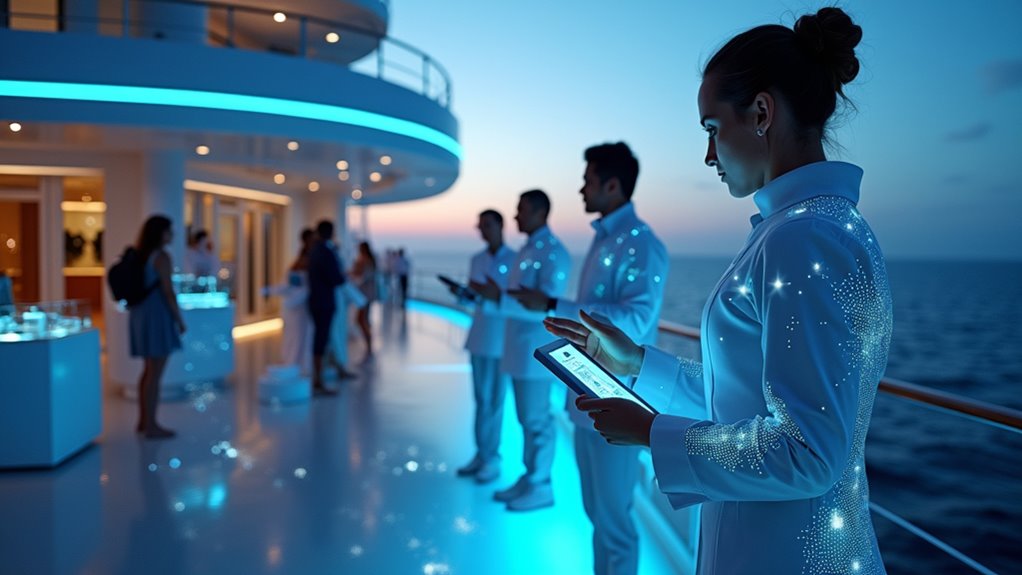
Technological innovations are transforming health monitoring aboard cruise ships by enabling faster, more accurate responses to onboard medical needs. Telemedicine is gaining momentum thanks to increased satellite bandwidth, allowing you to consult with doctors remotely within hours. Specialized services like telepsychiatry and teledermatology reduce the need for shore referrals, improving onboard health outcomes. Real-time video consultations and rapid report sharing mean quicker diagnoses and treatment plans. Wearable devices, such as smart wristbands, monitor vital signs, track contact, and support touchless payments, enhancing safety. AI-driven analytics analyze health data continuously, flagging potential outbreaks early. Integrated surveillance and proactive alerts help prevent disease spread. These innovations ensure you receive prompt, efficient care, making cruising safer and more comfortable.
Frequently Asked Questions
How Will These New Protocols Impact Cruise Ticket Pricing?
You might notice that cruise ticket prices could go up because of the new safety protocols. As the industry invests in advanced surveillance, upgraded water and air systems, and staff training, these costs get passed on to you. Plus, increased demand for safer cruises might allow lines to charge more. While prices could rise, you’ll also benefit from improved safety and confidence during your voyage.
Are There Specific Health Requirements for Children and Elderly Passengers?
Did you know that in 2025, cruise lines may require specific vaccinations for vulnerable groups? You’ll need to verify children and elderly passengers meet health requirements, including CDC and WHO guidelines. This might include proof of COVID-19 or flu vaccinations. You should carry adequate medications and documentation. Non-compliance could lead to denied boarding. Always check with your cruise line beforehand to meet all health protocols for a safe, smooth voyage.
Will These Safety Measures Delay Embarkation or Disembarkation Processes?
You might wonder if safety measures will slow down embarkation or disembarkation. Generally, these protocols are designed to improve efficiency and safety, so they won’t cause significant delays. Contactless check-ins, pre-boarding health screenings, and streamlined procedures help speed up the process. While some adjustments like crew training and system upgrades could cause brief delays, overall, these measures aim to make boarding and disembarking smoother and quicker for you.
How Are Crew Members Trained to Enforce New Health and Safety Standards?
Imagine stepping into a bustling training room, where you’re immersed in hands-on lessons. You learn to enforce health and safety standards through updated protocols, mastering PPE use, hygiene practices, and emergency procedures. Active drills and scenario simulations sharpen your response skills. You’re equipped with clear communication tools and knowledge, ensuring you confidently uphold safety measures onboard, protecting everyone’s well-being and maintaining smooth, secure cruise operations.
What Contingency Plans Exist for Outbreak Management During Voyages?
You’ll find that cruise ships have detailed contingency plans for outbreak management during voyages. These include rapid illness reporting, isolating affected individuals, and increasing cleaning efforts. You’re expected to follow established protocols, communicate with crew, and stay informed through updates. In addition, ships coordinate with health authorities, utilize telemedicine support, and have emergency procedures prepared. These measures guarantee you’re protected and the outbreak is controlled swiftly.
Conclusion
By adopting these new safety protocols, you’ll sail into a safer, healthier voyage where every measure acts as a sturdy shield protecting you like an unbreakable fortress. These advancements create a seamless safety net, ensuring your journey is smooth and worry-free. As the waves of innovation roll in, you can trust that your cruising experience will be brighter and more secure, turning the open sea into your personal sanctuary of safety and adventure.
Claire, a creative soul with an unquenchable thirst for storytelling, is an integral part of the Voyager Info team. As a dedicated writer, she weaves captivating narratives that transport readers to enchanting cruise destinations and beyond.
Claire’s love affair with writing began at an early age when she discovered the magic of words and their ability to craft worlds and emotions. Her innate curiosity led her to explore various literary genres, but it was travel writing that truly captured her heart. Drawing inspiration from her own globetrotting adventures and encounters with diverse cultures, Claire embarked on a journey to become a travel writer par excellence.
